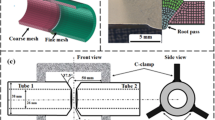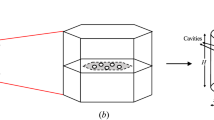Abstract
This paper presents constitutive equations that describe the hot flow behaviour of Virgin (VG) X20 and rejuvenated heat-treated creep exhaust (CE) X20 steels. The study provides a foundation for determining the effect of rejuvenation heat treatment on CE steels by making comparisons to the VG steel. Hot compression tests were conducted in the temperature range of 900 °C to 1050 °C, at strain rates of 0.1–10 s−1 to a total strain of 0.6, and stress–strain curves were obtained. The flow stress curves of both steels exhibited dynamic recovery (DRV) characteristics as the main softening mechanism. Constitutive constants of steady-state stresses were determined. The stress exponents, n, were 6.62 (VG) and 5.58 (CE), and the apparent activation energy values were 380.36 kJmol−1(VG) and 435.70 kJmol−1 (CE). Analysis of the activation energies showed that VG steel had better workability properties than CE steel and was easier to deform at high temperatures. Constitutive equations for predicting the flow stress in the two steels were established. This were verified by statistical tools: Pearson’s correlation coefficient (R) and Absolute Average Relative Error (AARE). The results showed R-values were, 0.98 (VG) and 0.99 (CE), and the AARE values for VG were 4.17% and 9.01% for CE. The statistical parameters indicated a good correlation between the experimental and predicted values. The constitutive equations therefore adequately described the flow stress behaviour of both steels and can therefore efficiently analyse industrial metal forming schedules.









Similar content being viewed by others
References
Skobir DA, Godec M, Jenko M, Markoli B (2008) Characterization of the carbides in the steel X20CrMoV12.1 used in thermal power plants. Surf Interface Anal 40(3–4):513–517. https://doi.org/10.1002/sia.2759
Pandey C, Mahapatra MM, Kumar P, Saini N (2018) Some studies on P91 steel and their weldments. J Alloys Compd 743:332–364. https://doi.org/10.1016/j.jallcom.2018.01.120
Bakic G, Zeravcic V, Djukic MB, Perunicic N (2014) Material characterization of the main steam gate valve made of X20CrMoV 12.1 steel after long term service. Procedia Mater Sci 3:1512–1517. https://doi.org/10.1016/j.mspro.2014.06.244
Hald J (2008) Microstructure and long-term creep properties of 9–12% Cr steels. Int J Press Vessel Pip 85(1–2):30–37. https://doi.org/10.1016/j.ijpvp.2007.06.010
Brózda J, Zeman M (2003) Wrong heat treatment of martensitic steel welded tubes caused major cracking during assembly of resuperheaters in a fossil fuel power plant. Eng Fail Anal 10(5):569–579. https://doi.org/10.1016/S1350-6307(03)00039-6
Salifu S, Desai D, Kok S (2021) Numerical simulation and creep-life prediction of X20 steam piping. Mater Today Proc 38(xxxx):893–898. https://doi.org/10.1016/j.matpr.2020.05.125
Barraclough DR, Gooch DJ (1985) Effect of inadequate heat treatment on creep strength of 12Cr–Mo–V steel. Mater Sci Technol (United Kingdom) 1(11):961–967. https://doi.org/10.1179/mst.1985.1.11.961
Danielsen HK, Hald J (2006) Behaviour of z phase in 9–12%Cr steels. Energy Mater Mater Sci Eng Energy Syst 1(1):49–57. https://doi.org/10.1179/174892306X99732
Danielsen HK (2016) Review of Z phase precipitation in 9–12 wt-%Cr steels. Mater Sci Technol (United Kingdom) 32(2):126–137. https://doi.org/10.1179/1743284715Y.0000000066
Hu ZF, Yang ZG (2003) Identification of the precipitates by TEM and EDS in X20CrMoV12.1 after long-term service at elevated temperature. J Mater Eng Perform 12(1):106–111. https://doi.org/10.1361/105994903770343556
Hald J (1996) Metallurgy and creep properties of new 9–12%Cr steels. Steel Res 67(9):369–374. https://doi.org/10.1002/srin.199605503
Yan W, Wang W, Shan YY, Yang K (2013) Microstructural stability of 9–12%Cr ferrite/martensite heat-resistant steels. Front Mater Sci 7(1):1–27. https://doi.org/10.1007/s11706-013-0189-5
Danielsen HK, Hald J (2009) On the nucleation and dissolution process of Z-phase Cr(V, Nb)N in martensitic 12%Cr steels. Mater Sci Eng A 505(1–2):169–177. https://doi.org/10.1016/j.msea.2008.11.019
Cipolla L, Danielsen HK, Venditti D, Di Nunzio PE, Hald J, Somers MAJ (2010) Conversion of MX nitrides to Z-phase in a martensitic 12% Cr steel. Acta Mater 58(2):669–679. https://doi.org/10.1016/j.actamat.2009.09.045
Cipolla L, Danielsen HK, Di Nunzio PE, Venditti D, Hald J, Somers MAJ (2010) On the role of Nb in Z-phase formation in a 12% Cr steel. Scr Mater 63(3):324–327. https://doi.org/10.1016/j.scriptamat.2010.04.025
Baldan A (1991) Rejuvenation procedures to recover creep properties of nickel-base superalloys by heat treatment and hot isostatic pressing techniques - A review. J Mater Sci 26(13):3409–3421. https://doi.org/10.1007/BF00557126
Lin S, Shen H, Zhou G, He W, Chen K (2022) A new rejuvenation heat treatment of crept Ni-based superalloy single crystals. IOP Conf Ser Mater Sci Eng 1249(1):012017. https://doi.org/10.1088/1757-899x/1249/1/012017
Falat L, Čiripová L, Homolová V, Džupon M, Džunda R, Koval K (2021)The effects of various conditions of short-term rejuvenation heat treatment on room-temperature mechanical properties of thermally aged P92 boiler steel. Materials (Basel) 14(20). https://doi.org/10.3390/ma14206076
Thomson RC, Bhadeshia HKDH (1992) Carbide precipitation in 12Cr1MoV power plant steel. Metall Trans A 23(4):1171–1179. https://doi.org/10.1007/BF02665048
Pandey C, Mahapatra MM, Kumar P, Saini N (2018) Homogenization of P91 weldments using varying normalizing and tempering treatment. Mater Sci Eng A 710(June 2017):86–101. https://doi.org/10.1016/j.msea.2017.10.086
Obiko J (2021) Friction correction of flow stress-strain curve in the upsetting process. IOP SciNotes 2(1):014401. https://doi.org/10.1088/2633-1357/abdd96
Li J et al (2022) Research on hot deformation behavior of F92 steel based on stress correction. Metals (Basel) 12(5):1–14. https://doi.org/10.3390/met12050698
Evans RW, Scharning PJ (2001) Axisymmetric compression test and hot working properties of alloys. Mater Sci Technol 17(8):995–1004. https://doi.org/10.1179/026708301101510843
Li Y, Onodera E, Chiba A (2010) Friction coefficient in hot compression of cylindrical sample. Mater Trans 51(7):1210–1215. https://doi.org/10.2320/matertrans.M2010056
Prasad YVRK, Rao KP (2008) Processing maps for hot deformation of rolled AZ31 magnesium alloy plate: Anisotropy of hot workability. Mater Sci Eng A 487(1–2):316–327. https://doi.org/10.1016/j.msea.2007.10.038
Xiao ZB, Huang YC, Liu Y (2016) Modeling of flow stress of 2026 Al alloy under hot compression. Adv Mater Sci Eng 2016:28–32. https://doi.org/10.1155/2016/3803472
Taylor AS, Hodgson PD (2011) Dynamic behaviour of 304 stainless steel during high Z deformation. Mater Sci Eng A 528(9):3310–3320. https://doi.org/10.1016/j.msea.2010.12.093
Ghosh S, Somani MC, Setman D, Mula S (2021) Hot deformation characteristic and strain dependent constitutive flow stress modelling of Ti + Nb stabilized interstitial free steel. Met Mater Int 27(8):2481–2498. https://doi.org/10.1007/s12540-020-00827-1
Obiko J, Chown L, Whitefield D, Bodunrin M (2022) Metal flow behaviour and processing maps of high heat resistant steel during hot compression. Int J Adv Manuf Technol 121(5–6):4153–4167. https://doi.org/10.1007/s00170-022-09577-3
Wang L, Liu F, Zuo Q, Chen CF (2013) Prediction of flow stress for N08028 alloy under hot working conditions. Mater Des 47:737–745. https://doi.org/10.1016/j.matdes.2012.12.074
Obiko J, Chown L, Whitefield D, Bodunrin M (2022) Understanding hot workability of power plant P92 creep resistant steels using dynamic material modelling (DMM) and microstructural evolution. Int J Interact Des Manuf. https://doi.org/10.1007/s12008-022-01084-9
Obiko J, Chown LH, Whitefield DJ (2019) Warm deformation behaviour of P92 steel. Mater Res Express 6(12). https://doi.org/10.1088/2053-1591/ab5e9c
Ge G, Zhang L, Xin J, Lin J, Aindow M, Zhang L (2018) Constitutive modeling of high temperature flow behavior in a Ti-45Al-8Nb-2Cr-2Mn-0.2Y alloy. Sci Rep 8(1). https://doi.org/10.1038/s41598-018-23617-7
Cai Z, Ji H, Pei W, Wang B, Huang X, Li Y (2019) Constitutive equation and model validation for 33Cr23Ni8Mn3N heat-resistant steel during hot compression. Results Phys. 15(July):102633. https://doi.org/10.1016/j.rinp.2019.102633
Jia L, Li Y, Zhang Y (2017) A Characterization for the deformation behavior of As-Cast P91 alloy steel and utilization in hot extrusion process. Adv Mater Sci Eng 2017. https://doi.org/10.1155/2017/6582739
Kumar N, Kumar S, Rajput SK, Nath SK (2017) Modelling of flow stress and prediction of workability by processing map for hot compression of 43CrNi steel. ISIJ Int 57(3):497–505. https://doi.org/10.2355/isijinternational.ISIJINT-2016-306
Nayan N et al (2021) Hot workability and microstructure control in Monel®400 (Ni–30Cu) alloy: An approach using processing map, constitutive equation and deformation modeling. Mater Sci Eng A 825(July):141855. https://doi.org/10.1016/j.msea.2021.141855
Mirzadeh H, Cabrera JM, Najafizadeh A (2011) Constitutive relationships for hot deformation of austenite. Acta Mater 59(16):6441–6448. https://doi.org/10.1016/j.actamat.2011.07.008
Laasraoui A, Jonas JJ (1991) Prediction of steel flow stresses at high temperatures and strain rates. Metall Trans A 22(7):1545–1558. https://doi.org/10.1007/BF02667368
Oudin A, Barnett MR, Hodgson PD (2004) Grain size effect on the warm deformation behaviour of a Ti-IF steel. Mater Sci Eng A 367(1–2):282–294. https://doi.org/10.1016/j.msea.2003.10.273
Alaneme KK, Babalola SA, Bodunrin MO (2021) On the prediction of hot deformation mechanisms and workability in Al6063/Nip and Al6063/steelp composites using hyperbolic-sine constitutive equation. Mater Today Proc 38(10):942–948. https://doi.org/10.1016/j.matpr.2020.05.463
Bodunrin MO (2020) Flow stress prediction using hyperbolic-sine Arrhenius constants optimised by simple generalised reduced gradient refinement. J Mater Res Technol 9(2):2376–2386. https://doi.org/10.1016/j.jmrt.2019.12.070
McQueen HJ, Ryan ND (2002) Constitutive analysis in hot working. Mater Sci Eng A 322(1–2):43–63. https://doi.org/10.1016/S0921-5093(01)01117-0
Zhou DQ, Xu XQ, Mao HH, Yan YF, Nieh TG, Lu ZP (2014) Plastic flow behaviour in an alumina-forming austenitic stainless steel at elevated temperatures. Mater Sci Eng A 594:246–252. https://doi.org/10.1016/j.msea.2013.11.021
Mirzadeh H (2015) Simple physically-based constitutive equations for hot deformation of 2024 and 7075 aluminum alloys. Trans Nonferrous Met Soc China (English Ed. 25(5):1614–1618. https://doi.org/10.1016/S1003-6326(15)63765-7
Carsí M, Peñalba F, Rieiro I, Ruano OA (2011) High temperature workability behavior of a modified P92 steel. Int J Mater Res 102(11):1378–1383. https://doi.org/10.3139/146.110603
El Wahabi M, Cabrera JM, Prado JM (2003) Hot working of two AISI 304 steels: A comparative study. Mater Sci Eng A 343(1–2):116–125. https://doi.org/10.1016/S0921-5093(02)00357-X
Wang S, Luo JR, Hou LG, Zhang JS, Zhuang LZ (2017) Identification of the threshold stress and true activation energy for characterizing the deformation mechanisms during hot working. Mater Des 113:27–36. https://doi.org/10.1016/j.matdes.2016.10.018
Baktash R, Mirzadeh H (2016) A simple constitutive model for prediction of single-peak flow curves under hot working conditions. J Eng Mater Technol Trans ASME 138(2). https://doi.org/10.1115/1.4032153
Mwema FM, Obiko JO, Mahamood RM, Adediran AA, Bodunrin MO, Akinlabi ET (2021) Constitutive analysis of hot forming process of P91 steel: finite element method approach. Adv Mater Process Technol 00(00):1–12. https://doi.org/10.1080/2374068X.2021.1939560
Funding
The authors declare that no funds, grants, or other support were received during the preparation of this manuscript.
Author information
Authors and Affiliations
Contributions
All authors contributed to the conceptualisation and design. Methodology and investigations were performed by Shem Maube, Japheth Obiko, Josias Van der Merwe, Fredrick Mwema, Desmond Klenam and Michael Bodunrin. The first draft of the manuscript was written by Shem Maube and all authors commented on previous versions of the manuscript. All authors read and approved the final manuscript.
Corresponding author
Ethics declarations
Competing interest
The authors have no relevant financial or non-financial interests to disclose.
Additional information
Publisher's Note
Springer Nature remains neutral with regard to jurisdictional claims in published maps and institutional affiliations.
Rights and permissions
Springer Nature or its licensor (e.g. a society or other partner) holds exclusive rights to this article under a publishing agreement with the author(s) or other rightsholder(s); author self-archiving of the accepted manuscript version of this article is solely governed by the terms of such publishing agreement and applicable law.
About this article
Cite this article
Maube, S., Obiko, J., Van der Merwe, J. et al. Constitutive analysis of hot metal flow behavior of virgin and rejuvenated heat treatment creep exhausted power plant X20 steel. Int J Adv Manuf Technol 132, 1843–1853 (2024). https://doi.org/10.1007/s00170-024-13443-9
Received:
Accepted:
Published:
Issue Date:
DOI: https://doi.org/10.1007/s00170-024-13443-9




